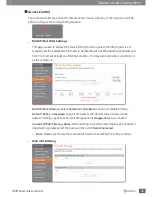
Appendix C: Glossary
45
300Mbps Wireless N Rouer
Appendix C: Glossary
•
802.11b:
The 802.11b standard specifies a wireless networking at 11 Mbps using direct-
sequence spread-spectrum (DSSS) technology and operating in the unlicensed radio
spectrum at 2.4GHz, and WEP encryption for security. 802.11b networks are also referred to
as Wi-Fi networks.
•
802.11g:
Specification for wireless networking at 54 Mbps using direct-sequence spread-
spectrum (DSSS) technology, using OFDM modulation and operating in the unlicensed
radio spectrum at 2.4GHz, and backward compatibility with IEEE 802.11b devices, and WEP
encryption for security.
•
DDNS (Dynamic Domain Name System):
The capability of assigning a fixed host and
domain name to a dynamic Internet IP Address.
•
DHCP (Dynamic Host Confi guration Protocol):
A protocol that automatically configure
the TCP/IP parameters for the all the PC(s) that are connected to a DHCP server.
•
DMZ (Demilitarized Zone):
A Demilitarized Zone allows one local host to be exposed to
the Internet for a special-purpose service such as Internet gaming or videoconferencing.
•
DNS (Domain Name System):
An Internet Service that translates the names of websites
into IP addresses.
•
Domain Name:
A descriptive name for an address or group of addresses on the Internet.
•
DSL (Digital Subscriber Line):
A technology allowing data to be sent or received over
existing traditional phone lines.
•
ISP (Internet Service Provider):
A company that can provide access to the Internet.
•
MTU (Maximum Transmission Unit):
The size in bytes of the largest packet that can be
transmitted.
•
NAT (Network Address Translation):
NAT technology translates IP addresses of a local
area network to a different IP address for the Internet.
•
PPPoE (Point to Point Protocol over Ethernet):
PPPoE is a protocol for connecting
remote hosts to the Internet over an always-on connection by simulating a dial-up
connection.
•
SSID (Service Set Identifi cation):
It is a thirty-two character (maximum) alphanumeric
key identifying a wireless local area network. For the wireless devices in a network to
communicate with each other, all devices must be configured with the same SSID. This is
typically the configuration parameter for a wireless PC card. It corresponds to the ESSID in
the wireless Access Point and to the wireless network name.
•
WEP (Wired Equivalent Privacy):
A data privacy mechanism based on a 64-bit or 128-bit
or 152-bit shared key algorithm, as described in the IEEE 802.11 standard.
•
Wi-Fi:
A trade name for the 802.11b wireless networking standard, given by the Wireless
Содержание FWR-714N
Страница 1: ......
Страница 53: ...www feixun com cn Shanghai Feixun Communication Co Ltd ...




































